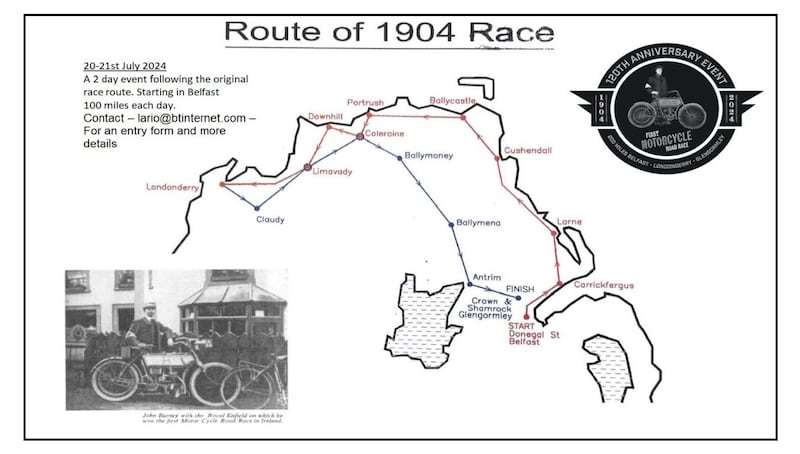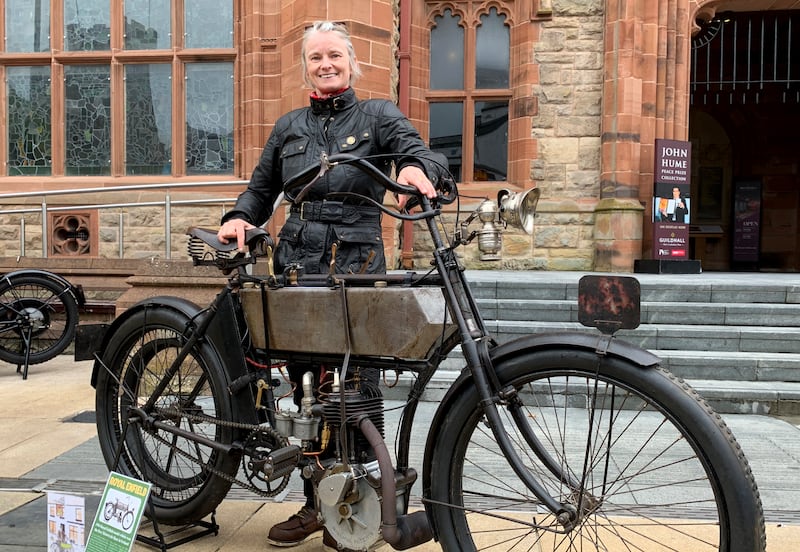A group of motorbike enthusiasts has retraced the route of what is believed to have been the world’s first motorcycle road race, which took place in Northern Ireland in 1904.
The route, from Belfast to Derry and back again, was early evidence of Northern Ireland’s enduring passion for motorbikes and helped spawn a road racing tradition of the type since popularised by the Isle of Man TT and several others in Northern Ireland, including the North West 200.
Modern motorcycle road racing sees riders and machines attain speeds in excess of 200mph (or 320+km/h), at times with tragic consequences. However, no such excesses attended a weekend riding of the original route by about 30 enthusiasts, some of them on machines almost as old as the race itself.
They included David Crawford riding a 1928 Moto Guzzi and his brother Eamon on a 1930 version of the same machine. Both bikes were in mint condition, as were their riders, though neither was born yesterday.
READ MORE
The 1904 race, billed at the time as a “reliability trial”, in part to disguise from the authorities what is was really about, was held on July 19th, starting from Donegall Street in Belfast and proceeding north along what is now the Coastal Causeway Route to Carrickfergus, Cushendall, and thence to Portrush, Coleraine and Derry. From there it turned back again via Maghera and Toombridge, ending at the Crown and Shamrock Inn in Glengormley.
Fifteen riders took part in the 200-mile race and would have been doing well to clock 40mph. The first man home was John Paul (JP) Burney of Belfast, riding a Royal Enfield, that looked more like a bicycle with an engine mounted under the crossbar than a modern-day motorcycle.
The 120th anniversary commemorative ride-out was organised in large measure by Joan Crawford, wife of David. A sprightly 81 years old, she marshalled the anniversary bikers for the off with the authority of a regimental commanding officer. They were gathered on Saturday morning in Belfast’s Donegall Street, starting point of the original race, and heard a short speech of good wishes from the city’s high sheriff, Councillor Sammy Douglas.

They rode out of the city in convoy along the Shore Road, much of it festooned with Orange Order bunting from July 12th. The bikes included some contemporary machines but most focus was on the vintage varieties. These included several Royal Enfields (a 1904 model was carried in a van), a James, a Triumph Coventry, a Vincent, a BSA, and a 1935 Excelsior Manxman.
Ridden by Trevor Marsden, the Excelsior emitted a tremendously loud Chitty-Chitty Bang Bang-like backfire, with a spurt of flame, each time it approached a junction and deaccelerated. “The overrun causes the backfire. The gearbox has been rebuilt and I’m testing it,” Trevor explained.
Eamon Crawford’s 500cc Moto Guzzi stalled at one junction. “I fluffed it,” he confessed before kick-starting it back into life.
Proceeding in convoy, the posse wended its way across the Sperrins and down into Derry, escorted into the city by two PSNI motorcycle police. At the Guildhall the ancient bikes were lined up and much admired, not least by Councillor Alex Duffy, chair of the business and culture committee.

Visiting bikers included JP Burney’s great granddaughter, Julie Horne, riding an almost new Royal Enfield adventure bike, a Himalayan. “I can’t imagine what it must have been like back then,” she said of JP’s 1904 achievement. “I’m riding a tarmac road today but back then there must have been a lot of gravel and mud and he did it in one day, all 200 miles of it.”
The re-enactment ended on Sunday in Glengormley.
Within a few years of winning the first motorcycle road race JP Burney had moved to Dublin where he ran a Royal Enfield dealership in Great Brunswick Street (now Pearse Street). In 1946 it became the Stanley Woods and Burney motor dealership. JP died in 1949
He is buried in Deansgrange Cemetery. Julie Horne plans to visit his grave later this week.
- Sign up for push alerts and have the best news, analysis and comment delivered directly to your phone
- Join The Irish Times on WhatsApp and stay up to date
- Listen to our Inside Politics podcast for the best political chat and analysis













